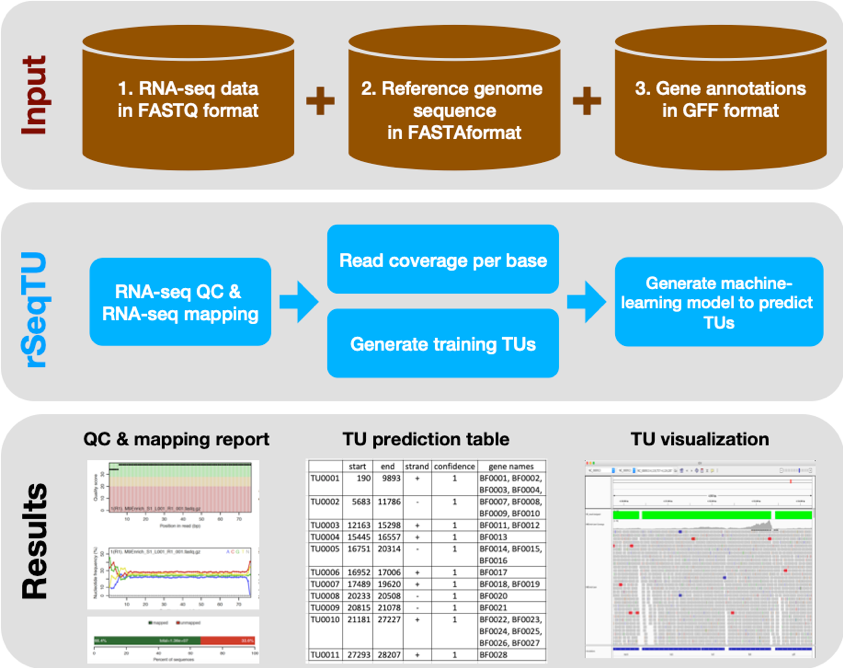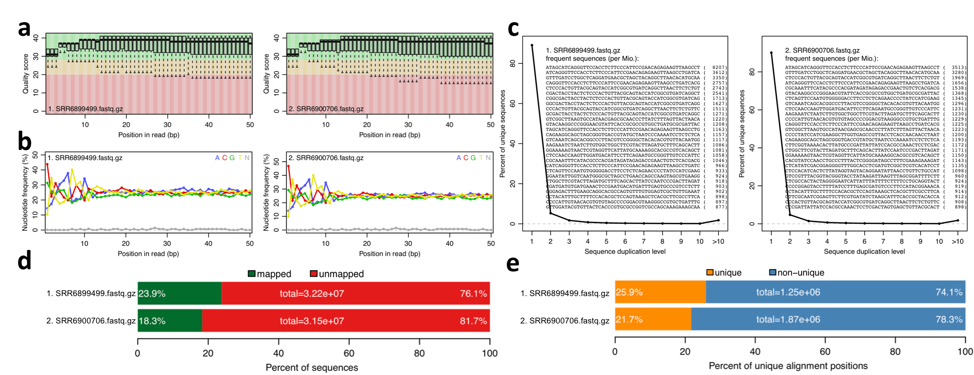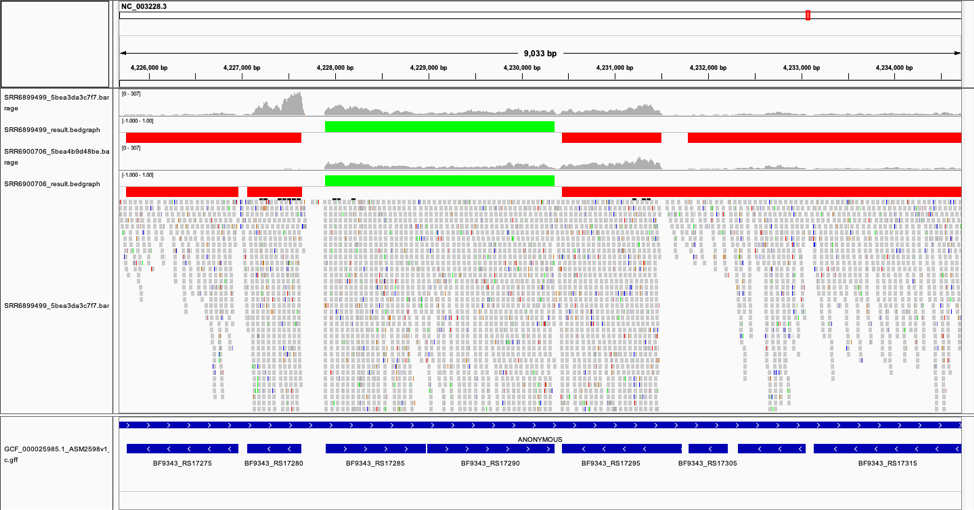A transcriptional unit (TU) is composed of one or multiple consecutive genes on the same strand of a bacterial genome. The genes within a TU are transcribed into a single mRNA to respond to specific growth conditions, and the TU are regulated by one promoter. To delineate the transcriptional regulatory networks, it is a crucial first step to identify TUs within a bacterial genome accurately. To allow users to efficiently perform TU identification on their machine and provide a more accurate prediction, we develop an R package, named rSeqTU. rSeqTU R package can automatically select essential TU features through a random forest algorithm in a machine learning framework. Besides, rSeqTU performs nearly 98% accuracy in most of our testing TU cases, e.g., public RNA-Seq datasets of E. coli. Users will be able to install the rSeqTU package from Github and input their customized RNA-Seq dataset to conduct de-multiplexing, quality controlling, reads alignment, random-forest-based feature selection, prediction model training, and TU prediction. Moreover, rSeqTU presents results in interactive visualizations for customized downstream analysis. rSeqTU also output read count matrix of both genes and TUs for further differentially expression analysis.
The rSeqTU R package has been tested on Mac and Linux OS.
GenomicRanges, Gviz, QuasR, Rsubread, caret, e1071, gridBase, mlbench, seqinr
library(devtools)
install_github("s18692001/rSeqTU")
library(rSeqTU)Please download the sample datasets from NCBI SRA database. Two data sets are SRR6899499 (ccfA overexpression) and SRR6900706 (wild-type). The reference genome sequence and gene annotations of Bacteroides fragilis NCTC 9343 are GCF_000025985.1_ASM2598v1_genomic.fna and GCF_000025985.1_ASM2598v1_genomic.gff.
library(QuasR)
library(Rsamtools)
library(rSeqTU)
library(seqinr)
setwd("/Users/syniu/rSeqTU/microbiome_test/data")
# Set up parameters of file paths for alignment
sampleFile <- "sampleFile.txt"
genomeFile <- "GCF_000025985.1_ASM2598v1_genomic.fna"
genome_gff <- "GCF_000025985.1_ASM2598v1_genomic.gff"
proj <- qAlign(sampleFile, genomeFile, paired="no", clObj = makeCluster(detectCores())) create 1 genomic alignment(s)
will start in ..9s..8s..7s..6s..5s..4s..3s..2s..1s
Testing the compute nodes...OK
Loading QuasR on the compute nodes...OK
Available cores:
nodeNames
xxxx
16
Performing genomic alignments for 2 samples. See progress in the log file:
local/QuasR_log_1ccc01b031f84.txt
Genomic alignments have been created successfully
# get Quality Check report and statistics
qQCReport(proj, pdfFilename="qc_report_test.pdf")
alignmentStats(proj) seqlength mapped unmapped
SRR6899499:genome 5241700 7692552 24556548
SRR6900706:genome 5241700 5774831 25756600
# Generate .NA file for constructing cTU
gen_NA("fastq/SRR6899499_5bea3da3c7f7.bam", "NC_003228.3", "SRR6899499")
gen_cTU_data("SRR6899499.NA", "SRR6899499", genome_gff, genomeFile)Reading the plot file ...
Reading gene annotations from the gff file ...
Done with reading gene annotations from the gff file ...
In this genome, there are
1) 2195 forward genes and
2) 2293 reverse genes.
Reading genome sequence for the fna file ...
Done with reading genome sequence from the fna file ...
The input genome is 5205140 bp long.
Reading intergenic regions ...
Done with reading intergenic regions ...
In this genome, there are
1) 2194 forward intergenic regions and
2) 2292 reverse intergenic regions.
11.Proportion of intergenic region's length and sum length of flanking two genes on forward strand: -5.605863 0.006151008 0.03838312 0.177702 0.2705315 0.9840084
12.Proportion of intergenic region's length and sum length of flanking two genes on reverse strand: -5.535354 0.006740167 0.04055088 0.1785426 0.2544108 0.9854094
# Train model and generate prediction result in .bedgraph format
TU_SVM("SimulatedPositiveTUMatrix.txt", "SimulatedNegativeTUMatrix.txt", "TargetPositiveTUMatrix.txt", "TargetNegativeTUMatrix.txt","SRR6899499.NA", genome_gff, "SRR6899499", "NC_003228.3")'data.frame': 2689 obs. of 17 variables:
$ ExpressionMean1: num 31.55 2.71 28.16 27.35 11.12 ...
$ ExpressionMean2: num 20.6 2 9.8 11.4 10 ...
$ ExpressionMean3: num 0 3.98 15.64 11.12 14.62 ...
$ ExpressionMean4: num 23 3.2 17 14.4 12.5 ...
$ ExpressionSD1 : num 9.97 1.16 11.59 12.04 5.25 ...
$ ExpressionSD2 : num 10.63 0 3.82 4.21 0 ...
$ ExpressionSD3 : num 0 2.58 3.91 3.03 10.17 ...
$ ExpressionSD4 : num 11.13 1.94 11.27 8.94 7.76 ...
$ GapProportion1 : num 0 0.0526 0 0 0 ...
$ GapProportion2 : num 0.0208 0 0 0 0 ...
$ GapProportion3 : num 1 0.122 0 0 0 ...
$ GapProportion4 : num 0.00379 0.07937 0 0 0 ...
$ GapLongest1 : int 0 7 0 0 0 0 0 0 0 0 ...
$ GapLongest2 : int 0 0 0 0 0 2 0 0 0 0 ...
$ GapLongest3 : int 0 12 0 0 0 18 0 26 5 0 ...
$ GapLongest4 : int 0 12 0 0 0 26 0 26 5 0 ...
$ GeneFoldChange : num 3.16e+06 1.47 1.80 2.46 1.31 ...
'data.frame': 910 obs. of 17 variables:
$ ExpressionMean1: num 252.22 22.69 1.34 1.21 13.03 ...
$ ExpressionMean2: num 58.6021 3.6 0.0673 1.4795 2.2349 ...
$ ExpressionMean3: num 13.574 1.655 13.279 13.031 0.446 ...
$ ExpressionMean4: num 69.78 10 3.09 6.1 2.49 ...
$ ExpressionSD1 : num 34.779 11.457 1.216 0.635 8.193 ...
$ ExpressionSD2 : num 52.408 0.807 0.349 1.224 3.144 ...
$ ExpressionSD3 : num 7.216 1.953 3.782 8.193 0.933 ...
$ ExpressionSD4 : num 76.83 12.63 4.72 7.8 5.3 ...
$ GapProportion1 : num 0 0 0.284 0.105 0 ...
$ GapProportion2 : num 0.0576 0 0.9519 0.1988 0.4095 ...
$ GapProportion3 : num 0 0.348 0 0 0.738 ...
$ GapProportion4 : num 0.0432 0.2053 0.2849 0.0909 0.561 ...
$ GapLongest1 : int 0 0 120 15 0 73 99 0 0 29 ...
$ GapLongest2 : int 110 0 99 22 17 0 61 0 16 206 ...
$ GapLongest3 : int 0 129 0 0 281 261 0 0 15 501 ...
$ GapLongest4 : int 110 129 177 22 367 261 99 0 16 501 ...
$ GeneFoldChange : num 18.58 13.71 9.87 10.77 29.22 ...
For tutorial of IGV, please check http://software.broadinstitute.org/software/igv/userguide
TU0001 67 722 + 1 BF9343_RS00005 BF9343_RS21315
TU0002 749 2218 + 1 BF9343_RS00010
TU0003 1147 2157 + 1 BF9343_RS21320
TU0004 2154 2889 - 1 BF9343_RS21325
TU0005 2211 3182 + 1 BF9343_RS00015
TU0006 2329 2889 - 1 BF9343_RS23515
TU0007 3196 3515 + 1 BF9343_RS00020 BF9343_RS21330
TU0008 3580 3798 + 1 BF9343_RS21335
TU0009 3830 4168 + 1 BF9343_RS21340
TU0010 4069 5729 + 1 BF9343_RS00025 BF9343_RS21345 BF9343_RS21350 BF9343_RS00030 BF9343_RS21355 BF9343_RS21360 BF9343_RS21365
TU0011 5893 7050 + 1 BF9343_RS21375
TU0012 6658 8469 + 1 BF9343_RS00035
TU0013 8217 8573 + 1 BF9343_RS21380
TU0014 8625 9743 + 1 BF9343_RS00040
TU0015 8696 8878 + 1 BF9343_RS23520
TU0016 9008 10570 + 1 BF9343_RS21385
TU0017 9724 10392 + 1 BF9343_RS00045
TU0018 10389 11747 + 1 BF9343_RS00050
TU0019 10586 11209 + 1 BF9343_RS21390
TU0020 11268 11702 + 1 BF9343_RS21395


